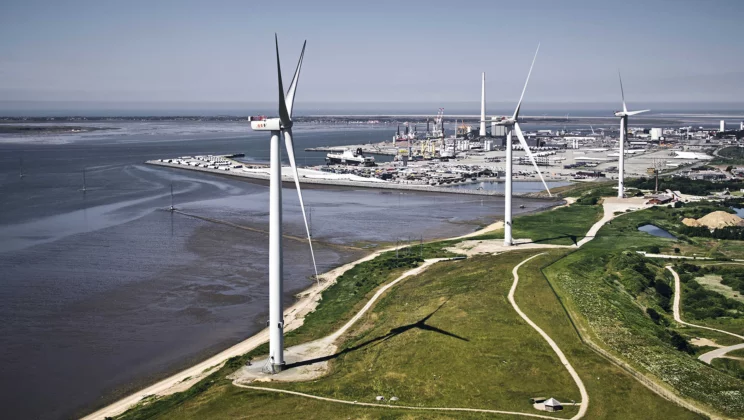750,000 m2 of extra space at the port of Esbjerg is now becoming a reality. According to experts, this indicates timely prudence in staying relevant in the pursuit of the ambitious offshore wind targets. “Not many ports in Europe can do what Esbjerg can,” says Jan Hylleberg, CEO of Wind Denmark. Port Esbjerg’s CEO calls it a milestone.
In 2026, 350 metres of new quay will be ready for use at the port of Esbjerg. The quay will be 50 metres wide and be equipped with a 30-metre-wide double loading platform for Ro-Ro vessels. All in all, the expansion by the new quay will add 750,000 m2 of extra space to the port area in Esbjerg.
The final decision was made on 24 September when the local council approved the expansion.
Project calculations and the Environmental Impact Assessment took more than five years, followed by consultations and the processing of comments. The approval covers the establishment of over 500,000 m2 of additional harbour area and another 76,000 m2 of sea, while a section of 170,000 m2 will be deepened to create new navigation channels and fairways.
“This is excellent news that shows, once again, that Port Esbjerg has had the forethought to act now,” says Hylleberg.

The port will be expanded to the east of the existing port.
The pace must be greatly accelerated
This statement was made as a result of the EU’s ambitious targets for offshore wind power. In autumn 2020, the Commission announced that the installed capacity of new wind turbines should be increased from 15 GW to 30 GW a year. The existing wind farms have a total installed capacity of just over 25 GW, but this figure must be 300 GW already by 2030.
This will require investments in port capacity. Otherwise, this massive expansion cannot be accomplished within such a short time. And Europe will not be able to deliver this target without huge investments in areas such as port infrastructure, heavy-loading quaysides, a strong supply chain and hydrogen infrastructure as well as the fundamental requirement of space.
The European wind industry association, WindEurope, estimates that EUR 6.5 billion of investment in port infrastructure will be needed around Europe by 2030. Port Esbjerg is taking an important and necessary step towards that goal by investing some DKK 500 million in the expansion.
“Without increased capacity for installation, assembly, operation and maintenance of offshore wind farms, we won’t be able to reach the targets. We’re therefore delighted to see that Esbjerg strives to remain attractive and relevant to retain the accolade of being the preferred originating port for offshore wind in Europe,” says Hylleberg.
He hopes the expansion will have a self-reinforcing effect and attract more businesses in the renewables industry to the port of Esbjerg.
Port Esbjerg CEO Dennis Jul Pedersen is also very pleased with the timing of the approval.
“It’ll take five years to complete the expansion, so now’s the time if we’re to reach the target. We got the approval, and this is a milestone for the port of Esbjerg,” says Jul Pedersen.
When the application was submitted five years ago, an energy island in the North Sea was not yet on the agenda, but politicians discussed building 10 GW of offshore wind in the Danish section of the North Sea. That was why Port Esbjerg applied for more space.
Originally, Port Esbjerg applied for an even larger expansion. But as the approval process for the total expansion made slow progress, Port Esbjerg separated out part of the project and submitted a new application which has now been approved.
Video her
Competition less of a problem than capacity
According to Jul Pedersen, the greatest challenge in the coming years will be to obtain sufficient port capacity. It may become a serious bottleneck unless ports throughout Europe ramp up their expansion activities.
“At Esbjerg, we’re among the first to expand capacity. And we’ll do our utmost not to stand in the way of the green transition on account of insufficient capacity,” he says.
Other ports in Europe are also in the process of investing. In Amsterdam, they are building an installation port, and expansions are also underway in Scotland.
However, Germany and the Netherlands are facing the same challenges as Denmark. It is difficult to expand because it is difficult to find space. And it is difficult to obtain approvals.
“I’m quite certain we can manufacture enough wind turbines to meet the targets set by the EU. But in order for the rest of the supply chain to keep up, there’s an urgent need for more space and faster case processing,” says Jul Pedersen.
There is no doubt in his mind that there is demand for the new square metres at the port. Over 30 per cent of the new port area has already been prebooked.
Besides the huge offshore wind capacity to be installed, additional space is needed due to the growing trend of assembling the turbines at the port site. And this requires extra space.
Port expansion to the east
The port will be expanded to the east of the existing port, thereby extending the port limits all the way to the Wadden Sea.
Port Esbjerg will only use the sand removed from clearing the fairway for the project. Dumping may therefore be avoided for a long period of time, making the expansion as sustainable as possible.
Already in November, Port Esbjerg expects to receive the first deliveries of sand to be used for filling the new area – initially around 230,000 m3 of sand.
The current expansion will follow two decades during which the port of Esbjerg already grew by more than two million square metres.
The entire port expansion is scheduled for completion in 2026.
Go to overview

